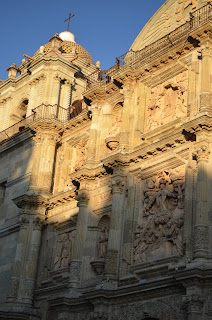While I’ve written a little about exploring the region around Oaxaca city, I wanted to add a little about the city itself.
The Zócalo, or central square, is filled with excellent people-watching opportunities. There are always vendors (balloons and games for children, drinks, and all kinds of souvenirs and crafts), musicians and other performers, and plenty of people, whether playing chess, meeting friends, shopping or simply strolling. During the time I was there, there was a festival for schoolkids to promote sports and dance (complete with public Zumba), demonstrations by the teachers (a common occurrence, I was told) and related to the inauguration of the new president.
 |
| Oaxaca Cathedral |
The region is known for the seven kinds of mole (or different complicated sauces with many spices and some using chocolate, usually served with chicken) made for special occasions throughout the state. The city has become a destination for its food both within Mexico and internationally and there are many restaurants offering creative takes on traditional dishes or interesting fusion options. Mezcal, a spirit distilled from maguey, is produced all around the area and many artisan producers sell their products in and around the city.
 |
| Mezcal bottles |
A particularly interesting spot, for domestic and foreign travelers alike, was the
Botanical Garden, which houses a variety of plants native to the region. Visits are available only by guided tour, which ensures that tourists leave with a decent understanding of some of the ecological uniqueness of the province and challenges of preserving the area native species. It’s also beautifully laid out, set into and around the grounds of the Santo Domingo church and Cultural Museum of Oaxaca (another treasure).
 |
| In the Oaxaca Botanical Garden |
One of my favorite things about the city was that by the time I was leaving, I still saw new places that I wanted to explore each time I crossed the center of the city. I hadn't come close to exhausting the list of restaurants and dishes that I wanted to try. There are many destinations for foreign and domestic tourists, but I think many people who live in and around the city are also able to take advantage of the events and cultural opportunities in Oaxaca.
I’ve already mentioned the
school where I took some Spanish classes and family I stayed with
here, but it’s worth repeating that my excellent experience was largely due to them and some of the other friendly people I met around town, fellow students and travelers, but also Oaxaqueños who took a few hours to exchange language lesson with me. Thank you!
